Rollerball
Rollerball was a science-fiction movie in the 70's about an imaginary sport game where two teams from a World urban league were fighting on a skating ring . The players were running after each other and their clashes were violent and rough like in American football. This chessgame tries to retrieve the idea.
Rollerball has an entry in D.B.Pritchard's "The Classified Encyclopedia of Chess Variants" (2007). It is one of the few chess variant to be described in Wikipedia.
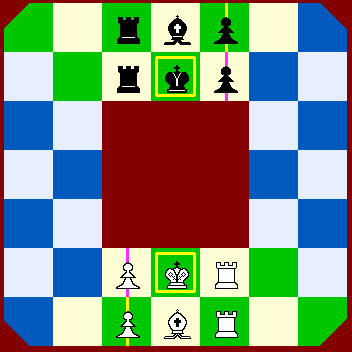
The board in a double ring of 40 squares made from a 7 x 7 with a 3 x 3 hole in the center. There is an inner ring and a outer ring. Also, it is convenient to see 4 zones, South, West, North and East.
Each side has 6 pieces only: 1 King, 1 Bishop, 2 Rooks and 2 Pawns.
White plays first.
All captures are by displacement as for Chess.
The play is mostly clockwise: generally speaking, the pieces move mainly ahead and have only limited motion backward. At every corner of the board, the pieces rotate 90°. Details follow.
All pieces change their orientation (rotating 90° clockwise) when they land on a corner or bend space (a1, b2, a7, b6, g7, f6, g1, f2).
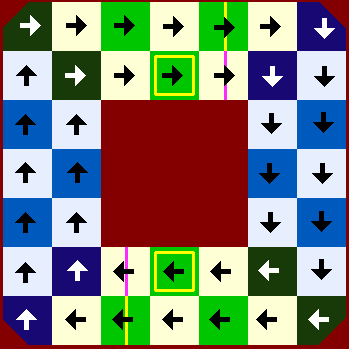
Main directions on the board. The squares where
direction changes are enlighted with white arrows
-
King: moves and captures exactly as in Orthochess to any adjacent square but never to a square where it can be captured. It is the only piece to have a symmetric move.
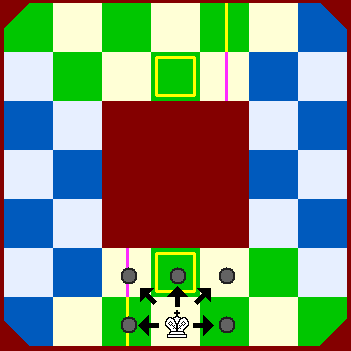
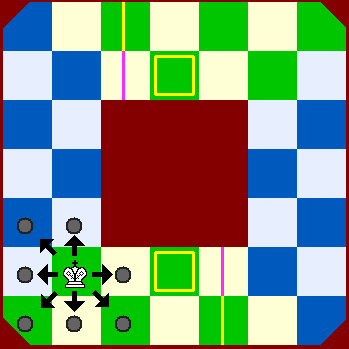
-
Rook: slides any number of squares forward or sideways along the row or column. Also, it can move 1 square only orthogonally backward. It never slides backward. On the external ring, they have one rebound allowed on the corners of the board.
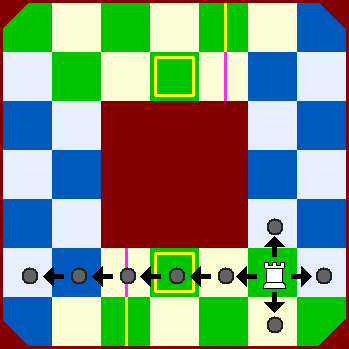

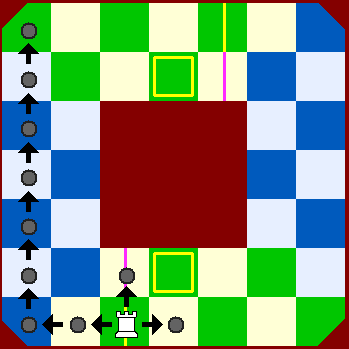
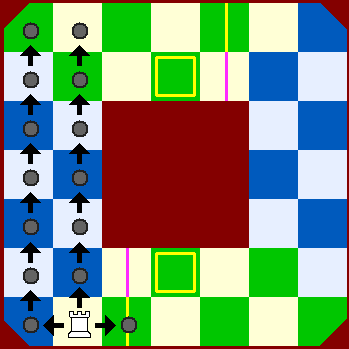
(A Rook on b1 (or a6, f7,g2) is so powerful that it can
mate without assistance)
-
Bishop: slides diagonally forward any number of squares with one rebound allowed on the sides, external and internal, of the board. Also, it can move 1 square diagonally backward. It never slides diagonally backward.
One may note that the white diagonals are forming another ring joining the mid-points of the external sides. The Bishop is very powerful there.
It can be noted that there is no Bishop on dark squares on the initial setup. However, a Bishop on dark square may appear by promoting a Pawn. A Bishop on a dark square has generally a modest mobility. -




(It can go to a2 only if it goes through b1)

-
Pawn: moves and captures forward straight or diagonally. When reaching the starting square of opposite Pawns it promotes to either a Rook or a Bishop. (Promotion to a Bishop upon dark squares is not recommended)
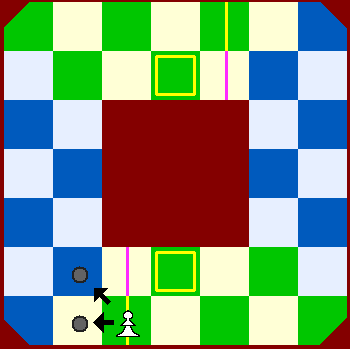

(b1 is ahead when Pawn is on c2)
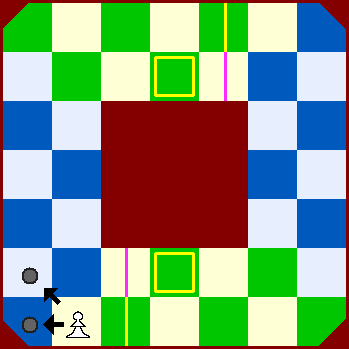
(b2 is sideway when Pawn is on b1 because it has not
turned yet)
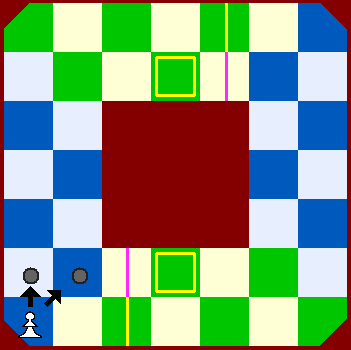
(b2 is ahead when Pawn is on a1, because it has turned)
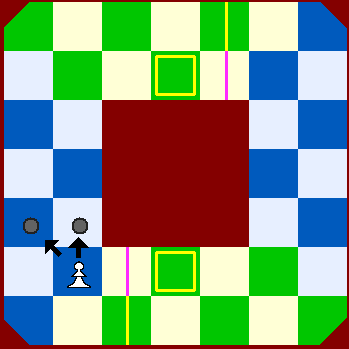
(a2 is sideway when Pawn is on b2 because it has
turned)
End of the Game: There are 2 ways to win the game:
- Checkmate the opposite King, or,
- When the King reaches the starting square of the opposite King, but only if had turned clockwise.
Stalemate is a draw. A 3-times repetition too.
Comment
Rollerball is a very tactical game. You can try it easily if you own Zillions of Games software, a zrf file being available.
Find the rules in the Chess Variant Pages.
![]() Rollerball est le titre d'un
film de science-fiction des années 70 qui s'articulait
autour d'un sport futuriste du même nom. Deux équipes
s'affrontaient à une sorte de football américain sur une
piste semblable à celle qu'utilisent les cyclistes pour
les épreuves de poursuite. Les joueurs se poursuivaient en
tournant dans un même sens, l'engagement des joueurs était
total avec des contacts violents et brutaux.
Rollerball est le titre d'un
film de science-fiction des années 70 qui s'articulait
autour d'un sport futuriste du même nom. Deux équipes
s'affrontaient à une sorte de football américain sur une
piste semblable à celle qu'utilisent les cyclistes pour
les épreuves de poursuite. Les joueurs se poursuivaient en
tournant dans un même sens, l'engagement des joueurs était
total avec des contacts violents et brutaux.
Les 6 pièces des joueurs se pourchassent en tournant sur une piste formée par un échiquier de 40 cases en anneau. Les parties sont brèves et demandent un bon sens tactique. C'est donc un très bon "jeu d'apéritif", avec de règles très facilement assimilables.
La piste est un anneau de 40 cases obtenu à partir d'un échiquier 7 x 7 auquel manquent les 9 cases centrales. Chaque camp est constitué de 6 pièces: 1 Roi, 1 Fou (sur cases blanches), 2 Tours et 2 Pions.
Les pièces avancent en tournant dans le
sens des aiguilles d'une montre. Les pièces changent leur
orientation (de 90°) à leur arrivée sur une case d'angle.
Les captures se font par substitution comme aux échecs.
- Pion : avance et capture d'une case droit devant ou en diagonale avant. Ne peut jamais reculer.
- Fou : avance et capture en suivant les diagonales. Il a le droit de rebondir 1 fois sur les bords de l'échiquier. Il ne peut reculer que d'une seule case.
- Tour : avance et capture droit devant ou latéralement. Lorsqu'elle se trouve sur la couronne extérieure de, elle a le droit de rebondir 1 fois sur l'angle de l'échiquier. Elle ne peut pas rebondir lorsqu'elle se déplace sur la couronne intérieure. Elle ne peut reculer que d'une seule case.
- Roi : avance et capture exactement comme le Roi orthodoxe.
Promotion du Pion : elle s'obtient en lui faisant faire un demi-tour, c'est-à-dire en l'amenant sur l'une des cases de départ des Pions adverses. Le Pion est promu en Tour ou en Fou, au choix. La promotion en Tour est souvent préférable.
La victoire s'obtient de l'une ou l'autre manière :
- par échec et mat du Roi adverse
- en étant le premier à amener son Roi sur la case de départ du Roi adverse en ayant tourné dans le sens des aiguilles d'une montre.
Le pat compte pour partie nulle.







